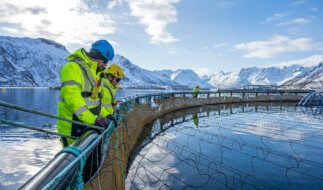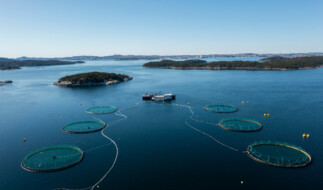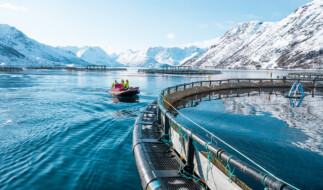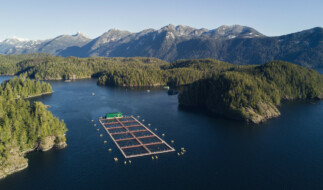Salmon is an excellent source of protein, healthy fats including omega-3 fatty acids, and several essential vitamins and minerals, making it an important contributor to healthy and sustainable diets. GSI members help ensure farm-raised salmon is one of the most eco-efficient animal-based proteins available, while maintaining salmon’s nutritional integrity and reducing pressure on the ocean’s resources.
Today’s global food systems face unprecedented challenges, and at the same time, offer many opportunities to drive widescale health, social and environmental progress. As the world’s population is projected to grow by billions in the coming decades, so too will the pressures on our planet’s resources. The status quo is no longer an option.
The link between environmental challenges, climate change, malnutrition, diseases and economic inequality is becoming clearer. Society is looking to the convergence of nutrition and sustainability for solutions. Change at speed and scale is essential to ensure global food systems can provide healthy, sustainable foods.
Sustainable aquaculture, including responsibly farmed salmon, plays a central role in helping to achieve global dietary recommendations, while offering a sustainable food choice.

Nutrient profile
Farmed salmon is a complete source of protein, healthy fats in the form of omega-3 and several essential vitamins and minerals. The average 3.5 oz. (100 g) portion of farmed salmon contains 41% of the recommended daily intake of protein and at least 20% of the recommended daily intake of vitamins B3, B5, B6, B12, vitamin D, vitamin E and selenium. It is also a good source of potassium, which is recommended by WHO to reduce blood pressure and risk of cardiovascular disease, stroke and coronary heart disease.
On average a 3.5 oz. (100 g) portion of farmed salmon also contains ~2 g of the omega-3 fatty acids eicosapentaenoic acid (EPA) and docosahexaenoic acid (DHA). Unlike alpha-linolenic acid (ALA), which is found in plant oils like flaxseed, EPA and DHA are unique to seafood; the best dietary sources are found in oily fish, like farmed salmon.
Health benefits
Research shows that eating seafood at least twice a week helps maintain a healthy heart and reduces the risk of cardiovascular diseases.
The omega-3 fatty acids EPA and DHA, especially when consumed from fish, are important for human health and are associated with multiple improved health outcomes, including early brain development, reduced risk of cardiovascular disease and stroke, alongside emerging research suggesting a lower risk of depression. The omega-3 fatty acids found in fish have also been found to help offset the adverse effect of heavy metals and environmental pollutants. Experts agree that the health benefits of eating fish, including farmed and wild salmon, far outweigh the possible risks from contaminants. You can learn more about food safety in our sustainability report here.
Eating about 8 ounces per week of a variety of seafood, including farmed salmon, as part of a healthy diet, can support health and development across the lifespan. Some types of fish, such as salmon and trout, are also natural sources of vitamin D, an important vitamin that many people don't get enough of.
- Reducing the risk of developing cardiovascular disease and mortality by lowering blood pressure and triglycerieds. ¹ ² ³
- Reducing the risk of coronary heart disease.²
- Supporting brain function and development in infants.⁴
- Possibly preventing psychiatric diseases, particularly cognitive decline in the elderly ³ ⁵ and reducing the risk of depression. ⁶
- Possibly preventing inflammation and reducing the risk of arthritis. ⁷
Frequently asked…
Are farmed salmon dyed pink?
Both wild and farmed salmon get their coloring from what they eat - specifically from an antioxidant called astaxanthin. Astaxanthin is even sold as a health supplement for humans. In the wild, salmon get astaxanthin from the krill and crustaceans they eat. On the farms, astaxanthin is added to to the feed to replicate the wild salmon's diet. In either case, it's an essential component to maintain the salmon's health.
Salmon in dietary guidelines
Global food-based dietary guidelines are evidence-based recommendations developed by government agencies that provide advice on maintaining a healthy diet and lifestyle. Around the world, these guidelines recommend regular consumption of fish, and particularly oily fish like salmon, due to its nutrient-rich profile, including protein, high levels of EPA and DHA, and other micronutrients.
Some guidelines – including those published by the Nordic Council of Ministers, Australia, Belgium, Denmark, Germany, Qatar and Sweden – are starting to recognize the importance of responsibly-sourced seafood in helping to meet nutritional needs. However, more awareness is needed around sustainable seafood certifications, and the contributions seafood makes to a safe, sustainable and healthy diet. One way to do this is for guidelines to consistently recommend third-party sustainability labels, such as Aquaculture Stewardship Council (ASC) certification. ASC is the most rigorous of farmed seafood labels based on environmental and social measures.
Spotlight on the Nordic Region
The Nordic Council of Ministers published its latest healthy eating advice in June 2023, via the Nordic Nutrition Recommendations (NNR). The NNR serve as the scientific foundation for nutrient intake recommendations and the development of food-based dietary guidelines in the Nordic and Baltic regions. The guidelines recognize that seafood is an important source of nutrition and the current average intake of fish and seafood in the region ranges from 5.3-17.6 ounces per week. This is below the NNR recommended 10-16 ounces (2.5 to 4 servings) of fish per week, of which at least 7 ounces should be fatty fish, including salmon.
The report concludes that the benefits of fish consumption on heart health, cognitive decline and metabolic syndrome have been mainly associated with omega-3 fatty acid content, but that fish proteins may also be important. The report recommends eating fish and seafood from environmentally sustainable sources and notes that aquaculture, already the main global seafood supplier, is expected to expand to satisfy increasing demand. It notes that consumers should prioritize fish and seafood purchases from sustainably managed farms and wild stocks.

Sustainable nutrition
The food choices we make can have significant impacts both on our health and on the planet.
Nutrient-rich and sustainable protein sources, like farmed salmon, are needed to feed a growing population with healthier, more sustainable diets. With a population set to reach nearly 10 billion by 2050, and a need to conserve the earth’s resources, responsible aquaculture offers one solution in providing highly nutritious and eco-efficient food.
Scientific findings from the Blue Food Assessment reveal that better integration of blue foods into national programs and policies can help reduce nutrient deficiencies, risk of cardiovascular disease, and the carbon footprint associated with food production and consumption. As food systems evolve, the GSI is proud to support the work of many global authorities, including the UN Food and Agriculture Organization and the High Level Panel for a Sustainable Ocean Economy, to ensure the industry continues to be managed responsibly, and support their recommendations for increasing seafood consumption.
GSI members help ensure farm-raised salmon is one of the most eco-efficient animal-based proteins available, while maintaining salmon’s nutritional integrity and reducing pressure on the ocean’s resources.





